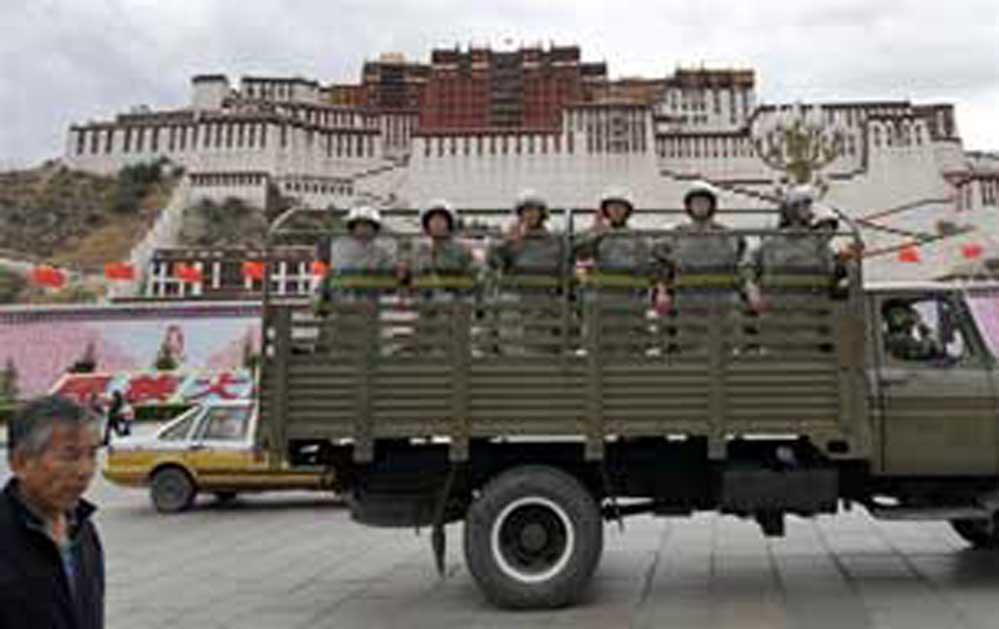There has been a visible acceleration over the past many months in the efforts of the Chinese authorities to diminish and undermine the XIVth Dalai Lama’s influence over Tibetans inside China. Additionally, this year is marked by a number of anniversaries in China's political calendar including the 70th year of the founding of the People’s Republic of China (PRC) in October, the founding anniversary of the People’s Liberation Army Navy (PLAN) in April as well as the sensitive 30th anniversary of the Tiananmen ‘incident’ in June and 60th anniversary of the XIVth Dalai Lama's flight from Tibet on March 10. The latter two would be cause for the most unease to China’s leadership. The current strain in Sino-US relations has added to Beijing’s worries.
Despite the investment of billions of dollars in development of the Tibet Autonomous Region (TAR) and steady tightening of the already stringent security measures in Tibetan populated areas, the Tibetans continue to be restive with occasional incidents of protest and self-immolation.
Qi Zhala, Chairman of the TAR Regional Government said in his Report on the Work of the Government to the second session of the 11th People's Congress of the TAR on January 10, 2019, that a total of 180,000 people in Tibet were lifted out of poverty. Emphasising the support to Tibet “by the State and Party”, the Global Times (January 11) warned people that the "hypocritical" side of the 14th Dalai Lama, who was “regarded as a separatist and fled into exile 60 years ago” should be clearly noted. On March 5, 2019, in his Report on the Work of the Government to the plenary session of the National People’s Congress (NPC) at the Great Hall of the People in Beijing, Chinese Premier Li Keqiang too particularly mentioned that special attention had been paid to poverty alleviation in areas of extreme poverty like the "three regions and three prefectures." These include Tibet and the areas of Sichuan, Yunnan, Gansu, and Qinghai provinces with large Tibetan populations.
Wu Sikang, Director of the Policy Research Office of the Shenzhen Municipal Government, penned an ‘internal’ report last October after a study visit to the U.S. in August 2018, which was particularly critical of the U.S. He specifically noted that the U.S. had, after a hiatus of some years, increased financial assistance to Tibetans from this year to US$ 17 million. In reality though, the overall quantum of U.S. financial assistance has not increased in the past couple of years, but the amount allocated for Tibet related activities in India and Nepal have this year been doubled from US$ 3 million to US$ 6 million. This has certainly aroused Beijing's suspicions and its concern is reflected to an extent in the enhanced attention being paid to Nepal. The announcement (February 22) by Nepal's Transport Minister, for example, that Nepal will use Chinese gauge standards for a planned nationwide rail network, points to China’s long term interest in Nepal. China has for long apprehended that Nepal would be used by “hostile foreign powers” as a launch pad for anti-China activities by Tibetans inside the TAR. Separately, Hu Shisheng, Director of the Institute of South and Southeast Asian and Oceania Studies in Beijing, touched on U.S. involvement in a remark to Global Times (January 11). He said, “Though some U.S. politicians might continue to play the Tibet card against China in 2019 on issues like human rights, China should ignore those political tricks and focus on exploring diverse development approach to the region.”
Attention of the Chinese leadership will particularly be focussed on the Dalai Lama’s annual message to Tibetans on the 10th of March. This comes in the midst of the 10-day plenary session of the National People’s Congress (NPC) – loosely called China’s parliament – underway in Beijing since March 5, amid heavy security. Contributing to Beijing's increased nervousness is the apprehension in Chinese Communist Party (CCP) leadership echelons that the U.S. has increased support to the Tibetans. Their concerns are reinforced by indicators that the Tibetans in China continue to venerate the Dalai Lama.
The TAR authorities have taken visibly heightened security precautions this year. Tibet has been placed off-limits to foreign and domestic tourists for an extended period this year from January 30 till April 30. On January 29, ahead of the Tibetan New Year ‘Losar’, the Executive Vice-Chairman of the TAR Party Committee inspected Lhasa’s two best known monasteries of Drepung and Gaden. Here he emphasised that “Tibet’s stability is vital to national stability, and maintaining Tibet’s security is akin to safeguarding national security.” Later, on March 7, large contingents of armed police and armoured personnel carriers paraded through Lhasa and the square in front of Potala Palace.
A special high-level meeting was also convened at the TAR Party School in Lhasa on February 21 to discuss how to prevent “major risks to national sovereignty” and security. Senior TAR leaders attended, including the Chairman of the TAR People’s Government, Political Commissar of the PLA Garrison in Tibet and the head of TAR’s security apparatus. The seminar was addressed by TAR Party Secretary Wu Yingjie. He urged cadres to cooperate with the Party in times of “new problems” and “new challenges” and called on them to intensify the “anti-separatist struggle”, proactively take social stability – an euphemism for security measures - initiatives to dilute the “negative influence of religion”, carry on the fight against the “Dalai clique” and achieve sustainable long-term stability. He asserted, in this context, the importance of accelerating construction of “well-off” border villages which are conceived as a protective ring around TAR’s international borders. Wu Yingjie has, incidentally, made a direct critical reference to the “Dalai clique” after a long time!
Reflecting the CCP leadership’s concerns, the Publicity Department of the TAR Regional Commission for Discipline Inspection, on February 1, 2019, released a 46-minute, 4-part video, which was aired on Tibet Television from January 28 to 31. It highlighted that Party officials having religious beliefs or “alleged” involvement in “separatism” or corruption were punished. The report bluntly accused some “two-faced” people in Tibet of claiming loyalty to the Party while secretly sympathizing with and even working for “separatists”. It was not clear how many Party members were exposed and punished and for what specific violations, though the video revealed that a total of 215 people had been punished as of October 2018. Xiong Kunxin, an Ethnic Studies Professor at Tibet University in Lhasa was, however, quoted as saying the regional government had already identified these people and was strengthening regulations to dismiss them.
CCP cadres are already deployed in each village of TAR thus expanding Party surveillance. Following the 19th Party Congress in November 2017, the state-run Tibet Daily disclosed that more than 20,000 party cadres had been sent to the villages and to 7,000 monasteries, to preach the Party’s message to the Tibetan people. China’s official media, on February 21, 2019, asserted that 800,000 Tibetans had been ‘educated’ in the spirit of the 19th Party Congress over the past 18 months and attributed this to holding 9,000 seminars and distributing 70,000 copies of publicity materials across the TAR.
Now in apparent confirmation that it had been decided to embark on a broader programme, the TAR authorities announced, on January 22, 2019, that a new training camp had opened in Shigatse in Tibet under paramilitary supervision to “correct” and “mould” the thinking of Party cadres. It has been tasked to carry out political “education” in the broader Tibetan society. It was separately announced that a large ‘Tibet Youth Palace’ will be opened in Lhasa in May 2019 to strengthen “patriotic education” among young people.
The Chinese appointed Panchen Lama, Gyaltsen Norbu, has also been co-opted in this effort. Speaking at a symposium on February 3 on the occasion of the 30th anniversary of the 10th Panchen Lama organised by the China Tibetology Research Centre, Gyaltsen Norbu, spoke of the 10th Panchen Lama’s dedication for the Chinese nation. He claimed that “separatist forces” - referring to the Dalai Lama and Tibetans outside China - were distorting and misusing the speeches of the 10th Panchen Lama and that he had never in his life once lost confidence in the Communist Party. He accused these “separatist forces” of misleading and deceiving the Tibetan people. The head of the CCP Central Committee (CC) United Front Work Department (UFWD) also met Gyaltsen Norbu on February 26, when he complimented him on the progress in his education.
Confirming that efforts to control and regulate worship of Tibetan Buddhism are part of planned central policy, the 48-year old Mayor of Lhasa and ethnic Tibetan, Guo Guo, told the Tibetan Deputies to the NPC and journalists in the Great Hall of the People on March 7, that “In 2018, Lhasa … took a clear-cut stand in eliminating the negative influence the Dalai Lama exerted via religion and took great effort in ridding the passive religious influence.” He added that the number of days spent observing religious events, and the number of people attending them had both been reduced to less than 10 per cent! Large sections of Tibetans comprising students, government and Party cadres and pensioners are known to have been warned that taking part in religious ceremonies and practices would attract punitive measures. The recent remarks of the Lhasa Mayor suggest that a number of activities of monks and monasteries have been curtailed.
(The author is a former Additional Secretary in the Cabinet Secretariat, Government of India and is presently President of the Centre for China Analysis and Strategy.)
Image Source: https://www.rfa.org/english/news/tibet/jail-12222008165412.html/Lhasa-Police-305.jpg/image










Post new comment